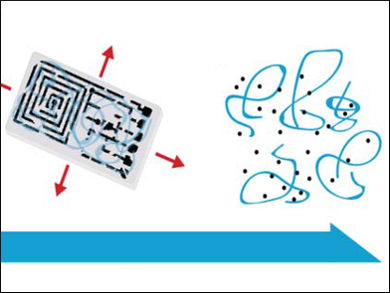Transient electrons are made to operate for a limited time before degrading away. One method for inducing transiency is through solvent-triggered dissolution. Reza Montazami, Iowa State University, Ames, USA, and colleagues control the life time of an electronic device through the use of colloidal electronic components mounted on a water-soluble polymer film.
The polymer film was made of poly(vinyl alcohol) (PVA), while the circuit consisted of conductive silver paste. Upon exposure to water, hydrogen bonds form between the water molecules and hydroxyl groups of the PVA, which causes the polymer chains to disentangle and diffuse apart. As the polymer matrix dissolves, the colloidal particles that form the circuit lose their mechanical support and disperse into solution.
After an hour of exposure to water, the circuit’s shape could be identified, but in the form of almost individual particles. By adding a sucrose to the PVA matrix in a 10:1 ratio of PVA:sucrose, the dissolution time could be reduced to 10 minutes. Larger amounts of sucrose reduced the dissolution time further.
Controlling the dissolution time in this manner allows for a variety of applications, such as biological sensors for the slow-dissolving devices and sensors for military use for the quickly dissolving devices. Furthermore, the circuitry could be preserved in the quickly dissolving devices by application to another surface, such as human skin or plants, similar to the transfer of a temporary tattoo.
- Study of mechanics of physically transient electronics: A step toward controlled transiency,
Simge Çınar, Reihaneh Jamshidi, Yuanfen Chen, Nastaran Hashemi, Reza Montazami,
J. Polym. Sci. Part B: Polym. Phys. 2015.
DOI: 10.1002/polb.23941


